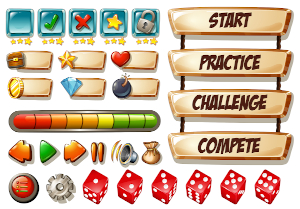Eva Rosa (a) y Carmen Berenguer (b)
(a) Dept. de Psicología Básica, Universitat de València, España
(b) Dept. de Psicología Evolutiva y de la Educación, Universitat de València, España

(c) Vecteezy.
Over the last decades, there has been a change in learning methodologies due to the increasing incorporation of playful elements. In the specific case of language learning, there are several video games and environments based on gamification for collaborative learning. Recent studies show the benefits of playful language learning in terms of vocabulary, grammar, writing, pronunciation, oral expression, and listening, as well as in terms of motivation, engagement, and satisfaction of the students.
Over the last decades, there has been a change in learning methodologies due to the increasing incorporation of playful elements. Since Abt coined the term “serious game” in 1970 to refer to video games and applications specifically designed to achieve a pedagogical and didactic objective, this kind of games have proliferated and gained popularity as an effective teaching tool for different types of populations, including populations with special needs (e.g., the StorySign application). In the particular case of learning a second language, it the acquisition of fluency skills in oral discourse is often difficult in the traditional group classroom settings. Serious games have emerged as an alternative that provides communicative entertainment, in a way that facilitates learning language skills. Crystallize and Hololingo are two examples of serious games for learning foreign languages.
On the other hand, the term gamification is an emerging concept that refers to the use of the mechanics and dynamics of the game in situations that are not a game itself, in order to increase motivation and commitment (Wu & Huang, 2017), and to reduce the anxiety and fear of speaking a foreign language in front of others (Lee & Hammer, 2011). The mechanics of the game include actions and processes such as feedback, levels, badges, points, virtual goods, leaderboards, and challenges; while the dynamics of the game refer to concepts such as self-expression, reward, achievement, altruism, fun, status, satisfaction, and competition, among others (Caballe & Clariso, 2016).
Although the elements of gamification can be used in real environments, they are especially characteristic of digital environments, where its potential applications are almost limitless. In recent years, some empirical studies have shown the benefits of the gamification of digital environments on the processes and outcomes of learning a second language. In a recent systematic review, Dehghanzadeh et al. (2019) found 22 studies, published between 2014 and 2019, that tested simple digital tools (e.g., Kahoot, Babbel, Duolingo) to support learning of English as a second language, aimed at the primary, secondary, and upper educational levels. The most used elements of the games were feedback, challenges, points, rewards, leaderboards and levels. Seventy percent of the reviewed studies found benefits for vocabulary learning, and 20% also obtained advantages for learning grammar, writing, pronunciation, oral expression, and listening comprehension. Beyond learning language itself, most studies also reported beneficial results in student motivation, engagement, and satisfaction. In almost all cases, the participants rated their learning experience positively.
Despite these encouraging results, it is necessary to carry out further research, since most of the previous studies suffer from methodological weaknesses, such as lack of control group or a pre-post-test design, short-term interventions, small samples, different instructors for treatment and control conditions, and overreliance on self-report measures, rather than actual learning measures. A recent systematic review (Bai et al. 2020) showed positive effects of gamification on learning achievements in various educational settings, but it also detected some limitations. Some of the analyzed studies revealed that gamification does not bring additional utility and that gamification causes anxiety or jealousy among students who fail to get a top position on the leaderboard, suggesting the need for improvements in the use of this resource. For example, an alternative to avoid jealousy would be to design learning tasks in such a way that students do not compete with each other, but rather try to improve their own results.
In summary, the conception, implementation, and evaluation of video games and playful environments for learning must be based on solid research. In the coming years, a growing development and improvement of emerging technologies is expected. Therefore, new opportunities and challenges will arise for the application of playful environments in different fields of education. The research available so far in the context of language learning reflects a growing interest in this methodology.
References
Abt, C. (1970). Serious Games. Nueva York: Viking Press.
Bai, S., Hew, K. F., & Huang, B. (2020). Does gamification improve student learning outcome? Evidence from a meta-analysis and synthesis of qualitative data in educational contexts. Educational Research Review, 30, 100322.
Caballé, S., & Clarisó, R. (2016). Formative assessment, learning data analytics and gamification. In S. Caballé & R. Clarisó (Eds.), ICT Education. Berlin: Morgan Kaufmann.
Dehghanzadeh, H., Fardanesh, H., Hatami, J., Talaee, E., & Noroozi, O. (2019). Using gamification to support learning English as a second language: a systematic review. Computer Assisted Language Learning. https://doi.org/10.1080/09588221.2019.1648298
Lee, J. J., & Hammer, J. (2011). Gamification in education: What, how, why bother? Academic Exchange Quarterly, 15, 146.
Wu, T. T., & Huang, Y. M. (2017). A mobile game-based English vocabulary practice system based on portfolio analysis. Journal of Educational Technology & Society, 20, 265–277.
Manuscript received on June 1st, 2021.
Accepted on September, 22nd, 2021.
This is the English version of
Rosa, E., y Berenguer, C. (2021). Beneficios de los entornos lúdicos para el aprendizaje de lenguas.
Ciencia Cognitiva, 15:3, 47-49.

